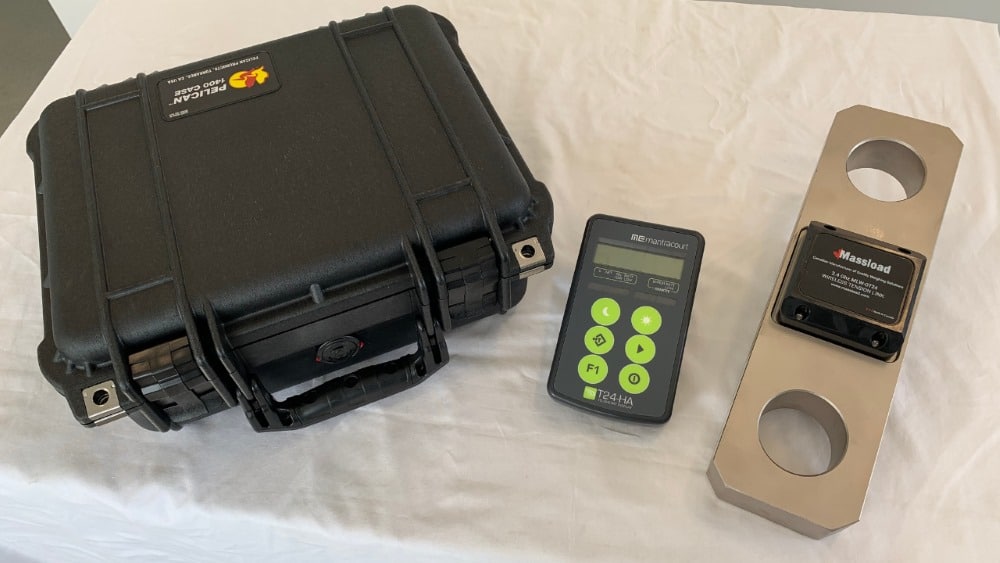
In industrial weighing, digital load cells are transforming how measurements are taken, offering significant improvements over traditional analog systems.
This guide covers everything you need to know about digital load cells including how they work, their key advantages, applications, and what to consider when choosing the right one for your operations.
What is a Digital Load Cell?
A digital load cell is a specialized sensor that measures force, weight, or pressure and provides a direct digital output, eliminating the need for external signal processing.
Unlike traditional analog load cells, which output a raw electrical signal, digital load cells have built-in electronics that convert and process the measurement signal at the source.
This integration delivers more accurate, stable, and reliable measurements, making digital load cells the preferred choice in many industries today.
How Does a Digital Load Cell Work?
Here’s how a digital load cell works:
- Force Detection: The load cell’s mechanical structure changes shape when a force or weight is applied.
- Signal Generation: Strain gauges inside the load cell detect this change and generate an analog signal.
- Digital Conversion: An analog-to-digital converter (ADC) converts the analog signal into digital.
- Data Output: The digital data is then processed by a built-in microprocessor and sends out a weight or force reading.
The main advantage of this is that the conversion happens inside the load cell, minimizing external noise and interference that can affect analog systems.
Digital Load Cell Components
Digital load cells have several integrated components that work together to give precise measurements:
- Strain Gauges: Sensing elements bonded to the load cell structure that detect change.
- ADC (Analog-to-Digital Converter): Converts the strain gauge’s output from analog to digital.
- Microprocessor: Processes the digital signal and applies calibration data for accurate readings.
- Communication Interface: Direct data output to display systems, PLCs or software platforms.
This combination of components gives high precision and minimizes errors during data transmission.
Types of Digital Load Cells
While there are many types of load cells, digital load cells fall into these categories:
Strain Gauge Load Cells: The Industry Standard
Strain gauge load cells are the most common type in digital weighing technology because of their high accuracy, reliability and versatility. They work on the principle of electrical resistance change.
Here’s how they work:
- Construction: Strain gauges are thin, flexible sensors bonded to a metal structure (aluminum, steel or alloy).
- Operation: When a force is applied, the metal structure changes shape slightly, causing a change in the resistance of the strain gauge.
- Signal Processing: This change in resistance is converted into an electrical signal, which is then processed by the built-in electronics of a digital load cell.
Applications:
Strain gauge load cells are general-purpose weighing, platform scales, tank weighing systems, hopper scales, and OEM machinery. They are good for static and dynamic weighing and can be customized for a wide range of capacities.
Advantages:
- High accuracy and repeatability;
- Cost-effective and widely available;
- Suitable for industrial environments.
Piezoelectric Load Cells: Dynamic Force Measurement
Piezoelectric load cells use the piezoelectric effect, where certain materials (like quartz crystals) generate an electric charge when mechanical stress is applied. These load cells are used in applications that require dynamic force measurements, such as impact testing, vibration analysis and high-speed weighing.
- Construction: The core of a piezoelectric load cell is made of piezoelectric crystals sandwiched between two metal plates.
- Operation: When force is applied, the crystals generate an electric charge proportional to the force which is converted into a digital signal.
- Signal Processing: The built-in electronics amplify and digitize the charge signal for precise measurements.
Applications:
Piezoelectric load cells are good for dynamic applications like impact force testing, automotive crash testing and laboratory experiments where rapid changes in force need to be measured accurately.
Advantages:
- High sensitivity to dynamic force changes;
- Good for high-frequency measurements;
- Compact and robust.
Limitations:
- Generally not as accurate for static weighing;
- More expensive than strain gauge load cells.
Capacitive Load Cells: High Sensitivity Applications
Capacitive load cells measure force by the change in capacitance between two conductive plates. When a load is applied, the plates move apart and the capacitance changes. This change is then converted into an electrical signal and processed by the digital circuitry.
- Construction: Capacitive load cells consist of two metal plates separated by a small gap, a capacitor.
- Operation: The load on the plates causes a slight movement which changes the capacitance value. The built-in electronics convert this change into a digital signal.
- Signal Processing: The digital signal is processed to give force or weight measurement, often with very high resolution.
Applications:
Capacitive load cells are used in laboratory, high precision weighing and sensitive industrial processes where small changes in force need to be measured.
Advantages:
- Very sensitive and high resolution;
- Stable in controlled environment;
- Can measure very small loads.
Limitations:
- Affected by environmental factors like humidity and temperature;
- More expensive and complex to install.
- Each type of digital load cell has its own advantages so knowing your application requirements is key to choosing the right digital load cell.
How Digital Load Cells Can Benefit Your Project
Digital load cells offer many benefits for your weighing system:
Higher Accuracy
- Digital signal processing;
- No noise interference;
- Built-in temperature compensation.
More Reliable
- Diagnostics and self-monitoring;
- Less calibration required;
- Long-term stability.
Better Integration
- Multi-protocol compatibility;
- Connect to PLCs, SCADA and cloud systems;
- Real-time data access for better control.
These features make digital load cells a good choice for industries that require high precision and data integration.
How to Choose a Digital Load Cell
When in the process of choosing the right digital load cell for your application, ask yourself the following questions:
1. Capacity and Range
- What is the weight range and peak load?
- What safety factor do you need?
2. Environment
- What is the temperature range, humidity and potential chemical exposure?
- Is the load cell protected against harsh environments?
3. Output and Integration
- Is the load cell compatible with your existing systems (e.g. communication protocol)?
- What data format and update rate do you need?
4. Compliance and Certification
- Does the load cell meet industry standards and safety regulations?
- By considering these, you can choose a digital load cell that will perform and integrate well with your system.
The Advantages of Partnering with Massload
Choosing a reliable digital load cell manufacturer can make all the difference. A trusted provider can offer:
- Access to a wide range of digital load cell technologies and suppliers;
- Customized solutions tailored to your specific needs;
- Expert support for system integration and troubleshooting;
- Ongoing maintenance and calibration services.
Working with an experienced team provider streamlines the implementation process, reduces downtime, and guarantees the best results.
Transform Your Business with Digital Load Cells: Let’s Find the Right Solution Together!
Digital load cells are redefining the standards of precision and efficiency in industrial weighing.
By providing accurate, reliable, and easily integrated measurements, they offer unmatched advantages across industries such as manufacturing, agriculture, mining, and oil and gas.
Interested in exploring digital load cell solutions for your business? Check out our digital weighing library or talk to our team today.


